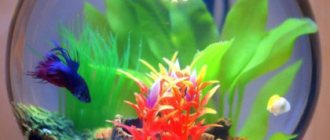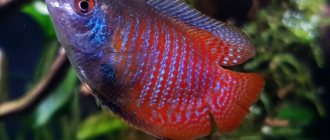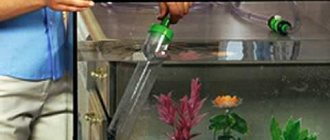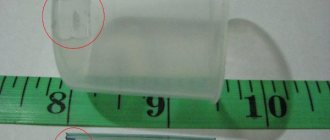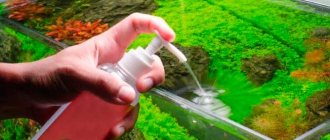Stones play an important role in composing the composition of the aquarium and building a “house” for the fish. Natural stones are not only a wonderful decorative decoration, but also help the inhabitants of the underwater world feel comfortable outside their usual habitat. The presence of stones successfully imitates the usual, natural habitat for fish; during spawning, they are necessary and convenient for building nests and laying eggs.
They can also serve as a refuge from the aggressive behavior of cohabitants and have benefits - they regulate water hardness. Choosing aquarium items and styling is not as easy as it might seem at first glance; this issue must be approached with all seriousness and responsibility.
Composition of stones in an aquarium
Purpose
Rocks in an aquarium perform several functions:
- decorate a pond and act as a design element;
- imitate natural habitat;
- suitable for creating shelters for underwater inhabitants;
- used by fish during spawning;
- with their help they fix algae at the bottom;
- serve as a natural regulator of water hardness and acidity.
Thus, in addition to purely external attractiveness, many fish need them for survival and reproduction.
What is Kenyan stone
Recently, Kenyan aquarium stone has gained great popularity. With it you can create a design that looks like the seabed. However, not all aquarists know about the composition of this stone and its effect on water.
Kenyan stone is mined on the shores of Lake Victoria in Africa. This is a sedimentary rock with a combined composition. It contains the following elements:
- limestones;
- calcite;
- dolomites;
- remains of fossil shells;
- traces of animal skeletons.
The stone contains a large amount of limestone, so it can increase the alkalinity and hardness of the water. This decor is not suitable for any home pond. Kenyan stone is ideal for a cichlid aquarium. These fish love hard water. In addition, the stone contains many pores and burrows, which can serve as shelter for cichlids.
Natural stones: pros and cons
Minerals taken from the natural environment have many benefits:
- cheap or even free material for decorations;
- variety of shapes and colors;
- look natural;
- easy to wash and clean;
- can be used to bring any composition into reality.
They have only one drawback: some rocks can change the hardness and acidity of the aquatic environment, sometimes to a critical level. This feature must be taken into account when arranging a home pond.
Sometimes natural stones are coated with dyes and glued together. If the work is done poorly, the composition will collapse and cause deterioration in the health of the fish. Below is a list of breeds commonly used by aquarists:
- Pebbles. Pebbles for an aquarium are a universal decor. Rocks that fall into bodies of water and are exposed to water for a long time acquire rounded shapes. They come in various sizes and colors, with veins and inclusions.
- Sandstone. Sedimentary rock that consists of sand and clay. Sandstone for an aquarium is not always a good decorative option, as it changes the hardness and acidity of the aquatic environment. In addition, some species are very fragile.
- Limestone. The basis of this mineral of sedimentary origin is calcium carbonate. Possible inclusions of magnesium salts and fossils. Has a solid or loose structure. Limestone increases the hardness and acidity of the aquatic environment and quickly becomes overgrown with algae.
- Granite. It is of volcanic origin. Does not release hazardous substances into water. A heavy multi-colored mineral with a mosaic of different colors. Often used by aquarists to build rock compositions. An aquarium with granite stones looks impressive.
- Gneiss. Slate is a type of solid rock that does not affect the water structure and composition. Pebbles with colored stripes can be safely used to create decor.
- Shell rock. The porous formation of compressed mollusk shells is easy to process to create an aquatic landscape. Shell rock is one of the most common rocks for decoration.
- Tuff . This porous rock is based on volcanic ash. Lightweight, durable, comes in a variety of colors. One of the rock varieties is calcareous tuff. A suitable material for arranging a home for fish that love an alkaline environment and many pitfalls.
- Quartzite. Small grains of quartz fused into one pebble. High strength, but at the same time it can be easily divided into parts. Quartz is found in pink and green shades.
- Gabbro-diabase. Stone of volcanic origin is one of the most durable and widespread in nature. Crushed stone is made from it and pavements are laid. The structure is compared to basalt. Does not emit harmful substances, suitable for creating underwater compositions.
- Jasper. A semi-precious solid opaque mineral that is not just a decoration, but also has special energy. The main component of jasper is quartz. It looks especially beautiful in red.
Varieties
Granite. This rock is of volcanic origin and is environmentally friendly. Granite colors are grey, black or white. Sometimes you can find orange specimens. The advantage of granite is its neutrality. It does not change the hardness and acidity of water.
Disadvantages include weight - small pieces weigh a lot, so when choosing granite, carefully study the strength of the aquarium glass. What types of decorative stones are there for an aquarium? In fact, a wide range of breeds can be used. Some are suitable for all containers, others only for certain types. Among the most popular are granite, gneiss, sandstone, and Kenyan stone.
- Gneiss. This stone also belongs to volcanic rocks, close in composition to granite. It is neutral and safe for fish and plants. The main advantage of gneiss and its difference from granite is its color. It is distinguished by the presence of light and dark horizontal stripes, which makes it an ideal material for decorating an aquarium, with which you can come up with the most intricate designs.
- Sandstone. Sandstone is a common sedimentary rock, characterized by a characteristic layered structure. Sandstone is formed when clay and sand are mixed. The stone can have different chemical composition depending on the sand. It must be used carefully: sandstone can increase the hardness of the water and affect its composition. Sometimes the stones turn out to be crumbly and fragile, and are not suitable for aquariums. Sandstone has different colors, it can be white or light gray, or cream, brown, red and even green and blue, allowing you to develop a unique design. The shape of the stone can vary, for example, cavernous sandstone is rough or smooth stones with numerous holes.
- Kenyan stone, or kenya. Kenya stone is a sedimentary rock and is one of the most beautiful species that allows you to create a unique design in an aquarium. It has a porous structure and uneven shape. Kenyan stone is formed by mixing limestones, calcites, sometimes in some specimens you can see imprints of shells. The structure determines the peculiarity of the chemical composition, so Kenya is suitable only for aquariums with a high alkaline composition and hardness, and the design of containers with soft water with it is unacceptable
Problems
One of the common problems associated with stones is the appearance of green or black deposits. This not only spoils the entire design, but also harms the inhabitants if nothing is done to eliminate it. Any experienced aquarist knows why this happens: stones and other objects, as well as the walls of the container, turn black or green for one reason - algae.
Blackening
Stones turn black not only for beginners, but also for experienced aquarists. Black plaque occurs due to the overgrowth of brown algae or diatoms. These uninvited guests also begin to coat the sides and other items in the container. The difficulty lies in the fact that first those stones that are located in darkened places turn black, so it is possible to detect the plaque quite late.
If stones turn black in your aquarium, pay attention to whether the conditions are being maintained. To eliminate black deposits, it is necessary to regularly change the water and control the lighting (stones often turn black in insufficient light). Another option is cleaner fish, but they will not be able to destroy all the plaque, so you will have to do the main work yourself. In addition to restoring the correct conditions, use a scraper to remove plaque from all accessible areas.
Greening
The appearance of greenery in an aquarium becomes a real disaster for novice aquarists. When the stones and walls turn green, it’s time to sound the alarm: you’re not paying enough attention to maintenance! Rare water changes and imbalances lead to the fact that the aquarium is literally full of greenery, plaque appears everywhere, from stones to the surface of the water.
First of all, pay attention to the light. Often, aquariums turn green due to the wrong spectrum of lighting: insufficient light, as well as too bright light, will sooner or later lead to the appearance of greenery. Keep an eye on the light regime, constant violation of which will soon cause plaque.
Another reason why the walls of the container turn green is contamination of the water with food. Do not overfeed the fish, try to give them enough food so that they eat it all and the particles do not settle to the bottom. It is also a good idea to clean stones and other surfaces from plaque with your own hands.
Harmful breeds
Experienced aquarists do not recommend using carbonates. They can increase water hardness and pH, thereby affecting the overall health of the fish tank. Although they are not harmful in all cases, it can be difficult for a beginner to determine the possible risks. Most often among carbonate rocks you can find:
- alabaster;
- coral;
- crushed shells;
- dolomite;
- limestone;
- many types of sandstone;
- marble.
The easiest way to test the rock's safety is to apply a few drops of white vinegar to the surface. If the liquid begins to fizz and bubble, the rock most likely contains carbonate. You can replace vinegar with hydrochloric acid to improve the accuracy of the test.
INTERNAL FILTER FOR AQUARIUM AND EVERYTHING YOU NEED TO KNOW ABOUT IT.
EXTERNAL FILTER FOR AQUARIUM AND EVERYTHING YOU NEED TO KNOW ABOUT IT.
THERMOREGULATOR FOR AQUARIUM AND EVERYTHING YOU NEED TO KNOW ABOUT IT.
AQUARIUM LAMPS AND EVERYTHING YOU NEED TO KNOW ABOUT THEM.
What stones should not be used
In order not to harm aquatic inhabitants, you need to adhere to certain rules. The following specimens should not be placed in the aquarium:
- selected near ore deposits;
- contaminated with chemicals;
- with any smell;
- large and heavy;
- with iron inclusions;
- soft of calcareous origin;
- large pebbles with sharp edges.
When choosing a stone for an aquarium, you should put aside a suspicious specimen, even if it is incredibly beautiful.
How to prepare stones for an aquarium?
Rocks selected for the aquarium
Preliminary cleaning of stones
Upon arrival home. I examined the selected stones more carefully and roughly figured out how they could be more advantageously placed in the aquarium.
Preliminary fitting of location
Of course, only some of the stones were used in the future, the rest were discarded.
How to prepare properly
Before you start making compositions, you need to properly prepare the stones for the aquarium so that they do not harm the aquatic biostructure.
Initial check and cleaning
To determine whether a mineral is carbonate, aquarists use the acetic acid test method. You need to take the stones and pour vinegar on them. If they hiss and bubble, then such specimens should be put aside. The material must be inspected for sharp edges, suspicious inclusions, and foreign odors. After the aquarium stones have been selected, they need to be cleaned with a brush. The bristles should be hard and the water should be running. Household chemicals cannot be used.
How to process stones for an aquarium
Simple mechanical cleaning is not enough. Bacteria are removed by heat treatment. Only prolonged boiling can kill bacteria. The stones are completely immersed in water and the pan is placed on the fire. High temperature will cope with the task better than any additives. The stones need to be boiled for half an hour over medium heat. They will keep warm for a long time. They are lowered into the aquarium only after they have cooled on a paper towel.
Special cleaning products
The effectiveness of disinfectant solutions is lower than that of boiling. However, many aquarists use them for cleaning. The stones are lowered into a large, durable container and filled with a solution in the concentration specified in the instructions for the drug. It is usually prescribed to leave decorative stones in the disinfectant for a day. Then take it out and wash it under the tap.
Attention! This procedure cannot be carried out when it comes to porous minerals; they will collapse. If the structure is not loose, it is better to boil it.
Preparing for the dive
Having made your choice, you need to prepare the pebble for immersion in the aquarium. Cleaning is carried out as follows:
- Selected specimens are washed under running water and rubbed with a stiff brush, removing dirt.
- The washed stones are left to dry. After drying, acid or vinegar is dripped onto the pebble to check the reaction. If multi-colored spots or bubbles appear on the specimen, it cannot be used.
- If there is no reaction to the acid, the selected specimen is washed again and boiled for 30 minutes.
- After calcination, the material is cooled and placed in a tank.
Correct placement in the aquarium
The prepared minerals are lowered into the tank after the placement has been thought out.
The following recommendations must be followed:
- The pebbles are distributed evenly along the bottom so as not to create a load. If you want to group the composition, you need to correlate the weight of the stones and the strength of the bottom.
- Large stones, especially natural ones such as granite and gabbro-diabase, are heavy. Therefore, their number is limited.
- Decorations should not be leaned against walls. If not immediately, then later the glass will burst under pressure, even if it is very strong. Only small pebbles can be placed near the walls.
- The structure itself must stand firmly. If the created stone structure falls on its side, aquatic life may be harmed or the glass may break.
- Rocks can be used to secure floating algae. It must be taken into account that the plants stretch out, become stronger and can turn the structure over.
Typically, tall decorations are attached to the bottom with silicone glue designed specifically for aquariums. No other glue can be used. The downside is that rearranging them if necessary will be problematic. It will not be possible to remove it from the tank to rinse and clean it. Therefore, it is advisable to think over a structure that will be reliable in stability, with a wide base.
Classification
The following types of aquarium stones can be found on sale:
- artificial;
- natural.
Artificial stones are made from plastic or glass. Polymer products are lightweight and can be used to construct various structures (rocks, grottoes). However, low-quality plastic pebbles can release toxic substances into the water and emit an unpleasant odor. Therefore, when purchasing them, it is necessary to find out exactly what compounds are included in such a product.
Glass decorative stones for aquariums are less durable than plastic ones. If handled carelessly, they can easily break. Such decor should not be purchased if the aquarium contains fish that like to play with stones and rummage through them. It is also undesirable to buy glass that is too small. Otherwise, the fish may swallow them and get injured.
Natural stones are divided into two types:
- processed;
- of natural origin.
Treated natural stones can be purchased at any pet store. Most often they are sold in the form of ready-made structures (rocks, grottoes, caves). However, such decor also has its disadvantages. Aquarium structures can easily fall apart if they are made from low-grade materials. And high quality products are quite expensive.
Therefore, many aquarists use stones of natural origin for decoration. Such products can rarely be found in pet stores; you have to collect them yourself. Stones are taken directly from natural conditions, for example, from the sea or river bank. Before placing them in the aquarium, they must be thoroughly washed and treated.
Living aquarium rocks can be classified into a special group. They are fragments of coral reefs. However, this decor is only suitable for sea fish. Inside the stones there can be various living organisms: beneficial bacteria, algae, crustaceans, mollusks.
Live rocks for a saltwater aquarium can act as a filter. They purify water from harmful impurities and convert ammonia into harmless nitrogen. In addition, decorations form shelters in which fish can hide. Live stones can be purchased at pet stores; the price of such products is quite high.
Decorations made of stones
Minerals can simply be beautifully distributed along the bottom or you can make various designs out of them. Grottoes, fairy-tale castles, and fantasy-style figures look good in an aquarium. You can use the stones in the aquarium to create original compositions with your own hands, which will become unique works of art. Such aquariums bring relaxation, similar to contemplation of the sea.
If an aquarist likes the aquascape technique, he needs to choose uneven, textured, dark rocks. Too smooth specimens without color inclusions look boring and unnatural. You should not select stones of the same color as the soil, they will merge and there will be no effect. Imitating a corner of a body of water is impossible without creating irregularities. It is advisable to leave the ground level only in the foreground. In this case, the landscape will look like a completed panorama.
When creating decorations, you need to remember that they need to be washed, cleaned, and cleared of green deposits. This procedure is performed at the time of water change. If you do not take care of stone structures, they will lose their individuality and merge into the general mass.
Self-collection of stones
Many aquarists collect stones for their home pond on their own. It is recommended to collect rocks in the following places:
- on the seashore or river bank;
- in quarries where marble and granite are mined.
Under no circumstances should you collect stones near quarries, or in places contaminated with toxic chemicals and radiation. It is prohibited to place ore in the aquarium. It should be remembered that an unsuitable or contaminated stone can cause mass fish deaths.
Testing
A good planning method involves testing the landscaping materials of the aquarium. Prepare a place where you can place rocks and driftwood , and then test different combinations, preferably on the layer of substrate you intend to use in the aquarium. Conducting the tests outside the aquarium means you can freely move objects in any direction without the risk of scratching the glass, which often happens in confined spaces inside the aquarium. Once the landscape architecture objects are in the right places, step back and look at the layout with an artist's eye. Ask yourself: are all the elements of the composition moving correctly? Is there enough negative (open) space? Where are the focal points? Do the stones match each other in their structure? Does the flow of water match the angle of the decor? Make sure each item has a purpose and complements the item next to it.
In this Iwagumi styled outdoor aquarium, it is advisable to replace the filter tubes with stylish glass ones to enhance the display. (Photo by Chris Penny)
Forget your plan
Once you've done your testing and the materials are ready to go, it's time for the final fittings: filters, CO2 system and lighting. All driftwood must sit in water for several days before it can be used in a water tank. All stones must be washed from dust. When you are finally ready to start implementing your plans, let everything take its course, forgetting about everything you had planned before, trust your instincts, and give free rein to your creativity. Your careful planning has taught you to avoid simple mistakes and outlined a rough plan for further work, but without spontaneous inspiration and intuition it is impossible to create an aquascape that you can then call your creation.
( To be )
Reference: Peter Hiscock – “Aquascaping: Style, Technique, Material” – “Tropical Habitat” Publication
